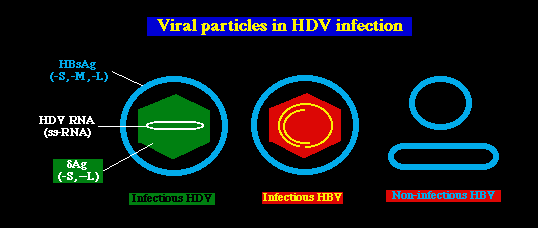Classification and Taxonomy
·
What are some of the basic properties of HDV?
·
What are the similarities and differences between HDV and Hepatitis
B Virus (HBV)?
·
What do the properties of HDV suggest about its evolution?
What are some of the basic
properties of HDV?
Family:
Not in any of the established viral families
Genus:
Deltavirus
Species: Hepatitis Delta
Virus (HDV)
· ssRNA negative sense
· can exist in circular and linear forms
· 1678 nucleotides long
· folds into dsRNA rod-like structure
· spherical virion 36nm - 24kDa delta antigen
· envelope is surface antigen of HBV (HBsAg)
·
In vivo replication dependant on coinfection with HBV
· self-cleaving ribonuclease (ribozyme) activity
· self-ligating
What are the similarities
and differences between HDV and Hepatitis B Virus (HBV)?

Source: Source: Perrotta,
Anne T.; Been, Michael D. "A pseudoknot-like structure required for
efficient self-cleavage of hepatitis delta virus RNA." Nature v350, n6317 (April 4, 1991):434.
The main similarity between HDV and HBV is that they
both have the same antigen on their envelope. This antigen is called HBsAg and
is vital to the structure of HDV but is not encoded by its genome. Another
similarity between these two viruses is that they cause similar
diseases and have similar means of transmission.
The main difference between HBV and HDV is the
genome. HBV has a double stranded DNA genome that is 3.2 kilobases long. The
HDV genome is a negative sense single-stranded piece of RNA that is only 1678
bases long. The capsid proteins of HDV and HBV are similar in structure but are
antigenicly distinct. In fact, HDV capsid antigen – called the Delta antigen –
was the first sign of the existence of HDV (see history).
HDV is also different in that it cannot replicate in a cell without coinfection
from another virus – HBV. For an explanation of how HDV replicates please see
the replication page. Surprisingly, there is no
significant homology between the genomes of HBV and HDV.
Yes and No. A virion of HDV certainly appears very
similar to a small, enveloped, icosahedral negative sense RNA virus. It has an
envelope with a surface protein, a icosahedral capsid and a (-)ssRNA genome. It
undergoes the traditional steps of viral replication (adsorption, penetration,
uncoating, transcription, translation, assembly, egress).
HDV, however, is not playing with a full deck. Its genome
does not encode for a envelope protein. Instead it steals the envelope protein
from HBV. In fact, HDV’s genome – at only 1678 bases – is significantly smaller
than any known animal virus. HDV cannot replicate in a cell unless the cell is
also infected with HBV. For these reasons HDV is classified as a “subviral
agent” or “satellite virus”. It is not a member of any of the recognized viral
families.
What do the properties of HDV suggest about its evolution?
One possibility for the evolution of HDV is that it
is simply a degenerate version of HBV. However, HDV and HBV do not share
significant genome homology so this route seems unlikely. The capsid of HDV is
similar in structure to HBV but they are distinct and their similarity might be
the result of convergent evolution.
HDV does have significant homology
with certain subviral agents of plants called viroids. HDV also has the replication properties of self-cleavage and self-ligation.
These also support the theory that HDV might have evolved from viroids. Here is
a comparison of the similarities and differences that HDV has with viriods and
other RNAs with HDV-like properties:
|
RNA (all of these are plant pathogens) |
Similarities to HDV |
Differences from HDV |
|
Viroids |
Small, circular genome Rodlike, highly base-paired secondary structure No homology with host genome RNA to RNA replication Self-Cleaving (ASBVd and PLMVd only) |
Smaller than HDV RNA Unencapsidated No-viroid-specific proteins Autonomous replication in vivo Most not self-cleaving Self-cleaving mechanism different |
|
Viroidlike Satellite RNAs (“virusoids”) |
Small, circular genome Rodlike, highly base-paired secondary structure Encapsidated in helper virus capsid No homology with host or helper virus genomes RNA to RNA replication Self-cleaving Limited Sequence similarities with HDV (less than
viroids) |
Smaller than HDV RNA Self-cleaving mechanism different No satellite-specific proteins No Autonomous replication in vitro demonstrated |
|
Satellite RNA of Tobacco Ringspot virus |
Small genome No homology with host or helper virus genome RNA to RNA replication Self-cleaving Limited Sequence similarities with HDV (less than
viroids) |
Smaller than HDV RNA +Strand mostly linear -strand self-ligating Self-cleaving mechanism different |
|
VS RNA |
Small, circular genome No homology with host genome Self-cleaving Some sequence similarities with HDV RNA |
Transcription from DNA intermediates The sequence similarities are only at the
self-cleaving site |
Source: Diner, Theodor. “Hepatitis Delta Virus-Like
Agents: An Overview”. Progress in clinical and biological research vol.
382. P. 112-114.